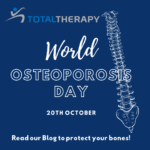World Osteoporosis Day – 20th October

Bone is a living tissue that is constantly being broken down and replaced. When you are young your body makes new bone faster than it breaks old bone and your bone mass increases. After your early 20’s this process starts to slow. The majority of people reach their peak bone mass density by the age of 30. Osteoporosis occurs when the creation of new bones doesn’t keep up with the loss of old bone decreasing its density.
What is Osteoporosis (OP)?
- According to the NHS, OP is ‘a health condition that weakens bones, making them fragile and more likely to break’. It develops slowly over several years and is often diagnosed when a fall or sudden impact such as a bump or sneeze that causes a bone to break or fracture. These can sometimes be life threatening and a major cause of long-term pain or disability.
- The most common injuries are: broken wrist, hip or vertebrae. More serious fractures such as the pelvis and spine can cause a stooped/bent forward posture. This is because the bones in the spine have broken, making it difficult to support the weight of the body.
Who is affected by Osteoporosis?
- Over 3 million people are affected in the UK
- Worldwide 1 in 3 women and 1 in 5 men over the age of 50 will suffer from an osteoporotic fracture.
- Women over 45 years old are more suseptable to OP due to a rapid loss in bone density during the first few years of menopause. The lowering of the sex hormone Oestrogen happens when women hit menopause, this hormone is important in bone health, cognitive health and functioning of the cardio-vascular system. Estrone is present after menopause, it is a weaker form of oestrogen.
- Other risk factors for developing OP include
- High does steroids
- Family history
- Eating disorders
- Low BMI
- Irregular exercise
- Heavy drinking and smoking
How to prevent and treat OP
- The international Osteoporosis foundation recommend 5 tips to healthy bones and a fracture free future
- Exercise – keep your bones and muscles moving with weight bearing, muscle strengthening and balance training exercises. Research has shown that high intensity resistance and impact training can help to increase bone density and reduces fracture risk. Walking, jogging, stair climbing and yoga are all great forms of exercise.
- Nutrition – make sure your diet is full of bone healthy nutrients. These include calcium, vitamin D and protein.
- Recommended daily amounts of calcium over the age of 50 are 1200 milligrams. The best way to get this into your diet is with low fat dairy products, dark leafy greens, canned salmon or sardines with bones, soy, and orange juice
- Vitamin D – this improves the body’s ability to absorb calcium and bone health in other ways. Sunlight is a good source of vitamin D however if you can’t get a lot of sunlight especially in the winter then cod liver oil, trout and salmon are a great dietary source. The recommended amount is between 600-800 international units per day.
- Lifestyle – avoiding negative habits to maintain a healthy body weight, avoid smoking and excessive drinking. It’s been shown people that have more than 2 alcoholic drinks a day are more at risk.
- Risk factors – let your GP know if you have any of the following, pervious fractures, family history of OP and take any medications that affect bone health includes steroids or prolonged use of anti-inflammatories
- Testing and treating – make sure you get tested – the use of a DEXA scan measures your bone strength and is compared to a healthy young adult and you will be given a ‘T’ score
If you have any questions about how you can make sure your bone health is as good as it can be please call or book online with us and we can talk everything through with you here at Total Therapy. We can give you advice and exercises that can benefit you and your bones!